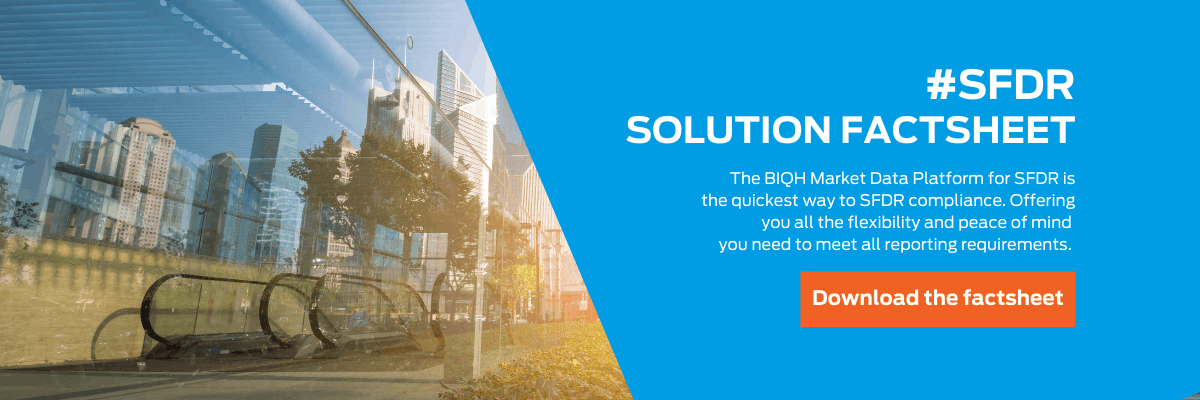Final SFDR RTS: European Commission adopts Regulatory Technical Standards under SFDR

The Sustainable Finance Disclosure Regulation (SFDR) came in effect slightly over a year ago. With the first reporting due date approaching quickly a new and final version of the Regulatory Technical Standards (RTS) was adopted by the European Commission last month.
This version of the RTS will most likely apply from 1 January 2023. Any additional changes before this date are not likely, although the European Parliament and Council still have time to object to the SDFR RTS.
The good news is this version of the RTS only contains a few non-substantive changes to the indicators and templates. Mostly additional clarifications on the requirements are provided. In this article we will briefly summarize the changes per Annex and we will conclude with some general guidelines to follow.
The latest SFDR RTS is available on the website of the European Commission.
Final SFDR RTS: Changes in Annex 1 – PAI statement on entity level
Annex 1 contains all the information on the Principal Adverse Impacts (PAI) statement. The number and characteristics for the indicators didn’t change at all. This means that if you already started up your data collection process, no changes to this process are needed.
Table 1, contains the mandatory indicators, table 2 contains the optional climate and other environment-related indicators and table 3 contains the optional indicators for social and employee, respect for human rights, anti-corruption and anti-bribery matters.
For the mandatory indicators it is now required to not only specify the ‘actions taken’ to support sustainability but also the ‘actions planned and targets set for the next reference period’.
For more information on the PAI statement, read also Sustainable Finance Disclosure Regulation [SFDR]: The Adverse Sustainability Impacts Statement.
Final SFDR RTS: Changes in Annex 2 – Pre-contractual disclosure for article 8 products
Annex 2 contains all the information for the pre-contractual disclosure for financial products referred to in article 8 of SFDR. The template itself hasn’t changed, however one additional requirement has been added to the document.
The following requirement applies for article 8 products with a designated reference benchmark for the purpose of attaining the environmental or social characteristics promoted by the financial product. In this case you should answer an additional question: ‘Where can the methodology used for the calculation of the designated index be found?’
Final SFDR RTS: Changes in Annex 3 – Pre-contractual disclosure for article 9 products
In Annex 3 a lot of additional comments and clarifications are added. For example, the question about ‘How have the indicators for adverse impacts on sustainability factors been taken into account?’ is complemented by a paragraph (in red) to explain what you should report on here. In this case you should include how the indicators of Annex 1 (PAI statement) are taken into account.
In case a reference benchmark is designated for the article 9 product, you should answer an additional question ‘Where can the methodology used for the calculation of the designated index be found?’
Final SFDR RTS: Changes in Annex 4 and Annex 5 – Periodic disclosure for article 8 & 9 products
Also Annex 4 and Annex 5 contain additional explanations. In both annexes there are now explanations given with the questions ‘What actions have been taken to meet the environmental and/or social characteristics during the reference period?’ (article 8 products) and ‘What actions have been taken to attain the sustainable investment objective during the reference period?. In the explanation, the Annexes are referring to a not existing article in Directive 2007/36/EC. However we believe the objective of this question is clear: one should provide a list here with all the actions taken during the reference period to meet either the environmental and social characteristics (article 8 products) or the sustainable objective (article 9 products).

General guidelines for using the final RTS under SFDR
To conclude we would like to mention some general guidelines on how to use this final Regulatory Technical Standards under SFDR.
The final RTS will apply from January 1st 2023. Until this moment you should already comply to this new regulation trying your best effort. The first PAI statement will be due on 30 June 2023 and should relate to the first reference period that is running from 1 January until 31 December 2022.
The final RTS now also mentions how to deal with the frequency of measurements, due to everchanging portfolios. The determination of the PAI indicators should take place at least four times a year and the average result should be published in the PAI statement.
The year to year comparison is a mandatory requirement starting from the PAI statement that is due in June 2024 (Reference period is 2023) and should at least contain five previous reference periods, if available.
‘Best effort’ under SFDR
Then one last, but not least important thing to remember. The final RTS is talking about ‘best effort’ in a few cases, especially related to Annex 1. According to the RTS a ‘best effort’ is:
“Where information relating to any of the indicators used is not readily available, financial market participants shall include in the section ‘Description of policies to identify and prioritise principal adverse impacts on sustainability factors’ in Table 1 of Annex I details of the best efforts used to obtain the information either directly from investee companies, or by carrying out additional research, cooperating with third party data providers or external experts or making reasonable assumptions.”
Currently, we see that it can be complicated to get all your ESG related data that is required for SFDR from one source. At BIQH we combine multiple sources to create a solid, complete and trustworthy PAI statement. The ESG data included is coming from well-known (market) data providers as well as from listed organisations.
Please don’t hesitate to reach out if you would like to know how BIQH can help you with getting all the data for SFDR in place.


